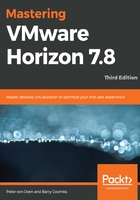
Persistent or non-persistent desktops?
In this section, we are going to talk about the different types of desktop assignments and the way a virtual desktop machine is delivered to an end user. This is an important design consideration, as the chosen method could potentially impact on the storage requirements (covered in the next section), the hosting infrastructure, and which technology or solution is used to provision the virtual desktop machines to the end users.
One of the questions that often gets asked is whether you should deploy a dedicated (persistent) assignment or a floating desktop (non-persistent) assignment. Desktops can either be individual virtual machines, which are dedicated to a user on a 1:1 basis (as we have in a physical desktop deployment, where each user effectively owns their own desktop), or a user has a new, vanilla desktop that gets provisioned, built, personalized, and then assigned to them at login. The virtual desktop machine they access is chosen at random from a pool of available desktops that the end user is entitled to use.
The two options are described in more detail as follows:
- Persistent desktop: End users are assigned a desktop that keeps all their documents, applications, and settings between sessions. The first time the user connects to it, the desktop gets statically assigned and is further used for all subsequent sessions. No other user is permitted access to the desktop.
- Non-persistent desktop: End users might be connected to different virtual desktops each time they connect. Environmental applications or user data does not persist between sessions and is instead delivered as the user logs on to their desktop using the composite desktop model we discussed back in Chapter 1, Introducing VDI and VMware Horizon 7. The desktop is refreshed or reset when the user logs off and is then ready for the next user.
In most use cases, a non-persistent configuration is the best option; the key reason is that using this model, you don't need to build all the desktops upfront for each user. You only need to power on a virtual desktop as and when it's required. All end users start with the same basic desktop, which then gets personalized before delivery. This helps with concurrency rates. For example, you might have 5,000 people in your organization, but only 2,000 ever log in at the same time; therefore, you only need to have 2,000 virtual desktops available. Otherwise, you would have to build a desktop for each one of the 5,000 users that might ever log in, resulting in more server infrastructure, more storage capacity, and more software licensing.
One of the things that used to be a bit of a showstopper for non-persistent desktops was regarding how to deliver the applications to the virtual desktop machine, and whether this would mean you had to install applications each time an end user logged in. Now that application layering solutions, such as VMware App Volumes or Liquidware FlexApp, are becoming a more mainstream technology, the applications can be delivered on demand as the desktop is built and the user logs in.
Another thing that we often see some confusion over is the difference between persistent and non-persistent desktops, and how cloning fits in. Just to make it clear, linked clones, full clones, and instant clones are not what we are talking about when we refer to persistent and non-persistent desktops. Cloning operations refers to how a desktop is built and provisioned, whereas the terms persistent and non-persistent refer to how a desktop is assigned to an end user.
Persistent and non-persistent desktops are purely about user assignment and whether an end user has a dedicated desktop, or one allocated from a pool on demand each time they log in. Cloning is a feature of Horizon View, which uses either View Composer and/or vCenter to create the desktop images for each user from a master or parent image. This means, regardless of having a persistent or non-persistent desktop assignment, the virtual desktop machine could still be a linked clone, full clone, or instant clone.
In the next sections, we are going to cover an in-depth overview of the cloning technologies available in Horizon 7, starting with Horizon View Composer and linked clones, and the advantages the technology delivers.